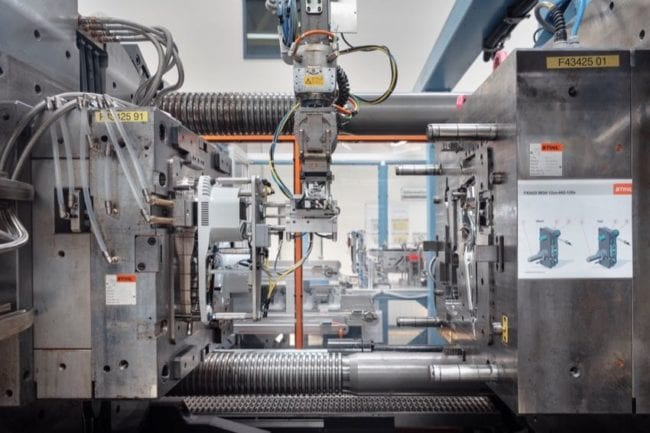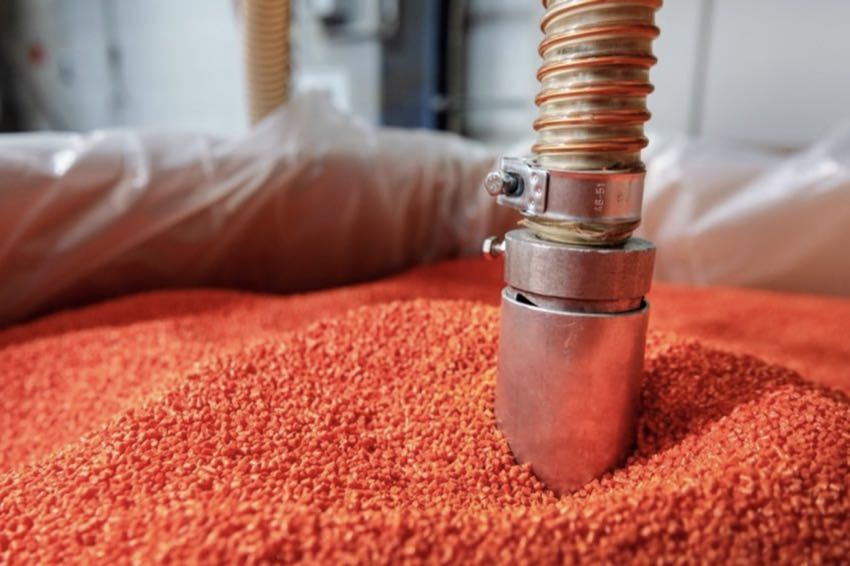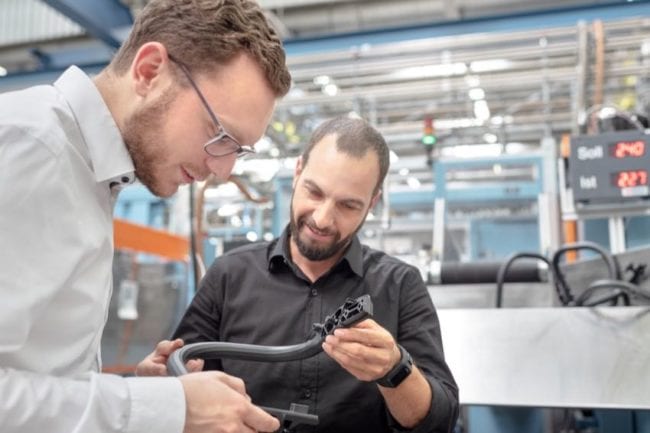Stihl has plastic production facilities in the USA, Germany, and also China. We recently got a chance to visit the Stihl plastic production center in Germany while checking out new tools and products. If you ever wondered how injection molding works, our conversation and tour at the plant offered up a ground-level peek at how it’s done. 233 people currently work in the German plastics plant in Waiblingen in 3 shifts.
Why InSourcing Plastic Molding Makes Sense
Stihl produces its own plastic parts to make products as lightweight and ergonomic as possible. Because many of their products utilize so many different materials, understanding the limitations and advantages of plastic lets them maximize its use in tools. In fact, almost all plastic parts such as battery covering hoods, hedge trimmer handles, and chainsaw housing parts are manufactured by Stihl itself.
How Injection Molding Works – The Process
Storing and Moving Plastic
Stihl uses mostly glass fiber reinforced plastics to give its parts more strength. These are similar to the type of plastic used in tool bodies. Given how injection molding works, to make lots of parts, you need lots of plastic. You also need the means to both store it and move it around the facility.
In the material storage room, we learned many sources of plastics converge to be stored and dried before use in production. One person per shift can run the entire room which supplies the factory with pellets (granulate). The glass-reinforced plastic pellets need to have the moisture removed via a drying installation. They also need to stay dry, so the room is dehumidified. This all works to ensure that the finished parts have no flow marks or bubbles.
Moving Plastic from Material Storage to Machines
Since there are 52 injection molded machines, vacuum pipelines feed each machine with the required granulate. The plastic source material comes in four colors: natural (for internal components), black, gray, and STIHL orange.
Looking up you can see that the entire facility is fed with these plastic pellets. Stihl says the injection molding machines process around 4,500 tons of plastic each year.
Molding Plastic
With the plastic injection molding machine receiving its “steady diet” if plastic, it can go to work. Most of the machines operate at up to 2,000 bars of pressure. That’s more than 29,000 pounds of force per square inch. Obviously you need very high clamping pressure (as much as 800 tons or more) to hold the molds together as the plastic is objected and sets. As you’d expect, hydraulics come to the rescue here.

You also need precision. The molds used to make these parts are very precise—down to 1/100th of a millimeter. Here’s a quick overview of how injection molding works and the entire process:
- Granulate is transported via vacuum lines directly from the drying installations to the injection molding machine and melted down.
- The viscous mass is injected into the corresponding mold which is compressed at up to 2,000 bar.
- The mold remains closed until the plastic has solidified. Water cooling speeds up the process.
- The finished part is removed by a robotic gripper arm and packed or sent on to the next process.
The entire facility had a high amount of automation to move pieces around and reduce the amount of physical labor needed to produce the various plastic parts. We saw robots everywhere. They seemed most effective when moving materials out of the plastic injection molding machines.
In-House Manufacturing Yields Advanced Concepts
One of the advantages of manufacturing plastic parts in-house is the ability to learn how to take advantage of certain process improvements.
For example, Stihl demonstrated a handle design whereby they “shoot” a pod through the middle of the mold to hollow it out. This process saves 40% of the weight without compromising the handle’s structural integrity. The process also ejects a significant amount of glass-reinforced plastic. Stihl happily recycles this as part of their workflow. The result is that the handles are made with 60% new material and 40% recycled material.
Concluding How Injection Molding Works
You might think a complex plastic injection molding process like this could lead to inconsistencies. Perhaps. To mitigate this, Stihl has several stages whereby finished pieces are weighed to the gram as part of a quality assurance step. This not only ensures that pieces are consistent and meet standards, but it also serves to flag problems with molds, machines, or other parts of the process that might need attention.
Since Stihl also produces many of their molds on their own, they maintain those molds so they last as long as possible (up to 1 million injections or more). As you can imagine, these are one of a kind and very expensive to replace or replicate. Checks and balances help keep everything working smoothly.
We loved learning how injection molding works. Hopefully, this piqued your interest as well and gives you some more appreciation for how much work goes into making that battery backpack, chainsaw, or power cutter. It certainly did for us.
For more infromation, please visit the Stihl website .
[amazon_link asins=’B013AQVQI0,B005NNF0YU,B00IJ0ALYS,B07FDPCFSM’ template=’ProductCarousel’ store=’opereviews-20′ marketplace=’US’ link_id=’43acb060-eb9f-464c-a695-54a40f1d7839′]



